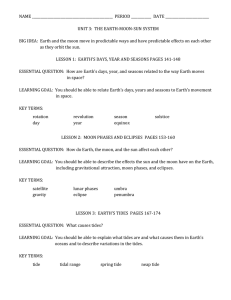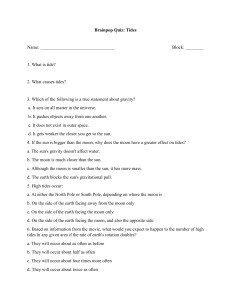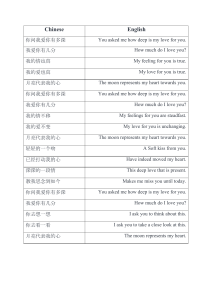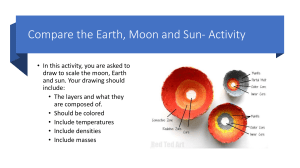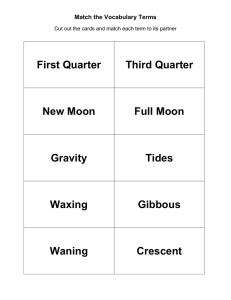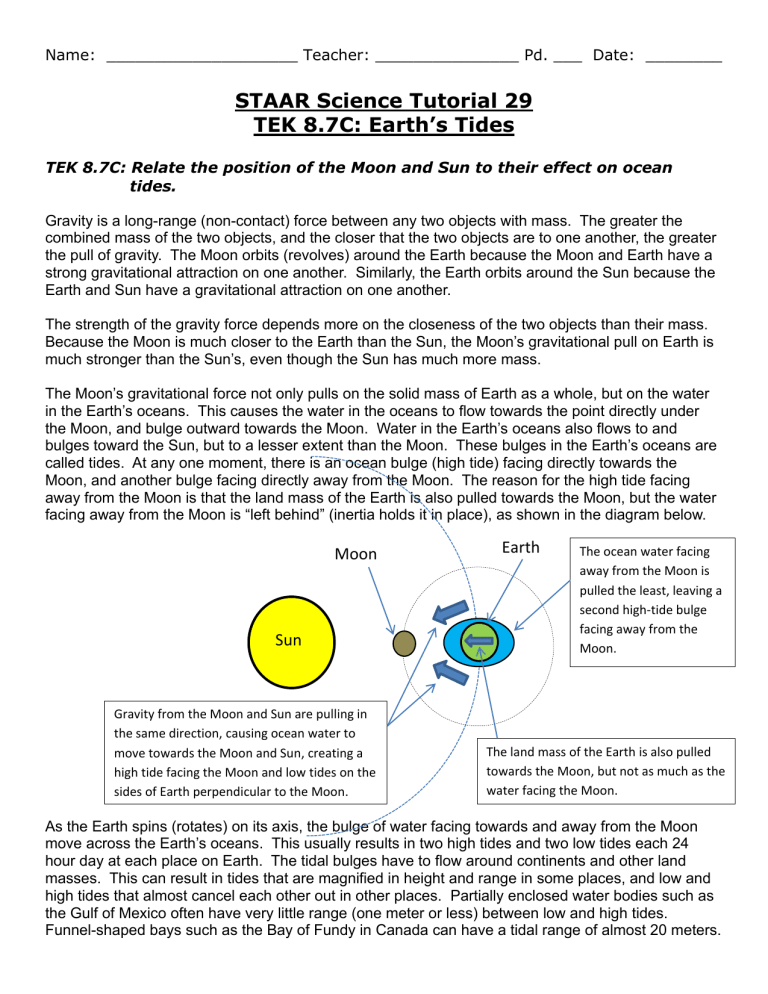
Name: ____________________ Teacher: _______________ Pd. ___ Date: ________ STAAR Science Tutorial 29 TEK 8.7C: Earth’s Tides TEK 8.7C: Relate the position of the Moon and Sun to their effect on ocean tides. Gravity is a long-range (non-contact) force between any two objects with mass. The greater the combined mass of the two objects, and the closer that the two objects are to one another, the greater the pull of gravity. The Moon orbits (revolves) around the Earth because the Moon and Earth have a strong gravitational attraction on one another. Similarly, the Earth orbits around the Sun because the Earth and Sun have a gravitational attraction on one another. The strength of the gravity force depends more on the closeness of the two objects than their mass. Because the Moon is much closer to the Earth than the Sun, the Moon’s gravitational pull on Earth is much stronger than the Sun’s, even though the Sun has much more mass. The Moon’s gravitational force not only pulls on the solid mass of Earth as a whole, but on the water in the Earth’s oceans. This causes the water in the oceans to flow towards the point directly under the Moon, and bulge outward towards the Moon. Water in the Earth’s oceans also flows to and bulges toward the Sun, but to a lesser extent than the Moon. These bulges in the Earth’s oceans are called tides. At any one moment, there is an ocean bulge (high tide) facing directly towards the Moon, and another bulge facing directly away from the Moon. The reason for the high tide facing away from the Moon is that the land mass of the Earth is also pulled towards the Moon, but the water facing away from the Moon is “left behind” (inertia holds it in place), as shown in the diagram below. Moon Sun Gravity from the Moon and Sun are pulling in the same direction, causing ocean water to move towards the Moon and Sun, creating a high tide facing the Moon and low tides on the sides of Earth perpendicular to the Moon. Earth The ocean water facing away from the Moon is pulled the least, leaving a second high-tide bulge facing away from the Moon. The land mass of the Earth is also pulled towards the Moon, but not as much as the water facing the Moon. As the Earth spins (rotates) on its axis, the bulge of water facing towards and away from the Moon move across the Earth’s oceans. This usually results in two high tides and two low tides each 24 hour day at each place on Earth. The tidal bulges have to flow around continents and other land masses. This can result in tides that are magnified in height and range in some places, and low and high tides that almost cancel each other out in other places. Partially enclosed water bodies such as the Gulf of Mexico often have very little range (one meter or less) between low and high tides. Funnel-shaped bays such as the Bay of Fundy in Canada can have a tidal range of almost 20 meters. The relative position of the Earth, Moon and Sun control the height and timing of tides. When the Sun and Moon are in line with one another, such as during a full moon or new moon, the tidal range is magnified, because the gravity from both the Moon and Sun are pulling in the same direction or axis. These are called “spring tides”, though they happen twice per the 29.5 day long lunar cycle, not just in the spring season. Spring tides have a very high tidal range—the high tides are very high, and the low tides are very low. The diagrams below show the two Moon positions for spring tides. Full Moon – Spring Tide Gravity from the Moon and Sun are pulling in opposite directions on the same axis, magnifying the high tides. New Moon – Spring Tide Gravity from the Moon and Sun are pulling in the same direction on the same axis, magnifying the high tides. When the Moon and Sun are at right angles (90 degrees or ‘perpendicular’) to one another, relative to Earth, during a 1st quarter or 3rd quarter moon, the tidal range is reduced because the gravity from the Moon and Earth partially cancel one another. These are called “neap tides”. Again, they occur twice in each 29.5 day long lunar cycle. Neap tides have a low tidal range—there is less difference between high tides and low tides, compared with spring tides. The diagrams below show the two Moon positions for neap tides. 1st Qtr. Moon – Neap Tide 3rd Qtr. Moon – Neap Tide Gravity from the Moon and Sun are pulling in different directions, partially cancelling out the high tides. Gravity from the Moon and Sun are pulling in different directions, partially cancelling out the high tides. Practice Questions 1. Tides are mainly caused by the force of ____________________ from the ____________________. 2. At any point on Earth’s oceans, there are _____________ high tides and _____________ low tides each 24 hour day. 3. High tides face either directly towards or directly away from the _____________. 4. Low tides face at _______________________ (90 degrees) to the Moon. 5. The tides that have the greatest tidal range are called _______________ tides. 6. The tides that have the lowest tidal range are called ________________ tides. 7. Spring tides occur during the __________________ and ________________ moon phases. 8. Neap tides occur during the __________________ and ____________________ moon phases. For questions 9-12, label each of the following diagrams with both the moon phase name and type of tide, draw a picture of the moon phase in the blank circle, and draw the two high-tide bulges in proper size and direction in relation to the Moon. 9. 10. ________________ ______________ ________________ ______________ 11. 12. _______________ ______________ _______________ ______________


